|
By Tom Carter
Staff Writer
Fast-paced, predominantly hard-sell and
programmed to lull the fickle audience into a kind of electronic euphoria.
That's AM "rock" radio in Lexington at WVLK and WLAP, where giving the
audience what it wants means playing more of the same hits more often.
Fast pace - the knack of fusing a commercial message and a rock hit into one
indistinguishable spiel - has been well-mastered here.
The hard-sell isn't totally dominant. Lexington is still enough of a country
town to harbor a few advertisers who won't tolerate it.
But listeners get more records per day here than in bigger markets, but not
a whole lot more.
At WVLK, approximately 35-40 contemporary records are played daily - in
addition to three "oldie goldie" hits per hour -- and at WLAP -- where
oldies are played one-to-one with current hits -- the record survey is 30
contemporaries (each played once every two hours) and 10 played three to
four times a day.
The city's third AM station, WBLG, is programming generally for "easy
listening" and is not geared to the same audience as the other two stations.
The multiple replays of the same stuff may sound like saturation to someone
who doesn't know Billy Preston from Barry White, but in the bigger market
stations there's even less variety.
More and more stations have moved into the rock music market in recent
years. The competition is fierce in bigger cities where stations play only
15 to 20 different top hits a day to keep the audience's attention.
But this has put the record industry into the position of releasing less
records because they get so little free air play anymore for the bulk of
them.
"Oldie" Problem
"Oldie goldies" are a big part of the problem.
The other is the teen-age (or younger) record buyer whose short-term,
ever-changing music preferences make the industry the maddening business it
has become.
The oldies are a broadcasting phenomenon. Old can mean a record from a few
months to several years out of its prime interest period, but most often
means records of the 1960s and late 1950s.
Herb Kent, program director at WLAP, says that he hasn't noticed any decline
in record production in recent years.
And both he and Jim Jordan, program director at WVLK, indicated that the new
record market is littered with losers.
Jim Allison, station manager at WLAP, doubted that any more new releases
would be played if the old records were not enjoying a revival.
"You'd probably only hear the new ones a little more frequently," he said.
But determining how often something should be played is decided after
someone determines what should be played.
At both WVLK and WLAP, the program and music directors have this chore and
disc jockeys aren't at liberty to deviate from it.
Both station's personnel review the music lists weekday. The barometers for
deciding what records should be played are:
- What are the stations in the bigger
markets play? Playing copycat isn't a bad risk when the copy is a
high-powered station like WABC in New York. Local stations get weekly
lists on what everybody is doing.
- What are people buying locally and
nationwide?
Both stations canvas record stores in
Lexington to see who is buying records or requesting records the stores
don't have.
Requests Count
Outside influences often affect the local
market if requests are made for a record many people have heard either on
other stations or while visiting or travelling out of town. Spotting a
trend-setter gives a local station an edge.
The nationwide sales figures come through trade magazines like Billboard and
Cash Box which keep track of current and promising hits as well as bad bets.
- Call-ins to the radio station. WVLK has
a request line with an automatic recorder. It is checked twice and hour.
"If people take the time to call in a
request, they obviously like it," Jordan said, adding that the day and night
call-ins generally reflect the tastes of the different audience and the
station changes its oldies to reflect it.
Admittedly, there is not much variety in music programming on rock stations
in markets the size of Lexington.
Variety usually happens in two other locations:
- Small towns with only one radio station
where programming variety isn't hampered by competition.
- In cities the size of Chicago, where
variety doesn't come from the individual stations, but among them.
Jim Allison, manager of WLAP, said a
station's goal is to get the biggest "share" of the market. In Chicago, the
classical, jazz or talk-show format share could be as large as the entire
Lexington area listening audience.
But in most cases, the rock audience is the best target for advertisers and
even in the biggest cities where stations are vying for it.
With the stations so concerned about giving a lot of time to the national
hits, it would seem discouraging to local talent which looks to the local
radio stations for promotion of the products. It is.
"We Listen…"
"We listen to them" comments Kent, "but we
can usually tell they're not going to be anything. I can usually listen to a
record and tell if it has it or not. Lexington is not a market for big
records."
Allison added, "It's a risk to play an unfamiliar record. Our people are
close enough to the business to be pretty sure of something before they play
it."
Jordan admitted that most local records can't compare technically with the
high-styled product from the big studios, but said, "We can give play to new
artists and hope that we can 'break' the record. We're a little luckier
because we're not in a major market."
Behind all this clamor to play the best of the least the most often is
ratings. The most popular stations can charge the highest advertising rates.
Besides, being number one is the point of doing anything with a commercial
bent to it.
The results of the annual survey of the local radio market will be out in
approximately two weeks. Number one -- WVLK is the apparent market leader --
will no doubt be vocal about it.
Figuring out who is number two, three, four, etc., will be another matter.
 |
|
By Tananarive Due
Herald-Leader staff writer
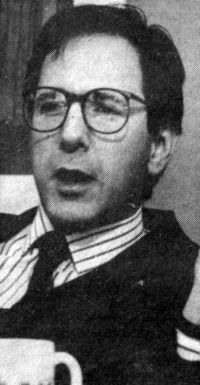 Paul
Hughes, president of Hughes Media Cos. of Lexington, describes himself as a
"multimedia enthusiast" but says that radio will always be his first love. Paul
Hughes, president of Hughes Media Cos. of Lexington, describes himself as a
"multimedia enthusiast" but says that radio will always be his first love.
Hughes has dreamed of owning his own radio
station since he was 16 years old. On May 27, that dream came true when his
first station, WMAK in London, signed on the air. He hopes a second station
will be on the air by next spring.
"It was a childhood dream. Once it's in your
blood, it never goes out," Hughes said, recalling that when he was growing up
in Baltimore, he built a recording studio in his bedroom so he could tape a
high school radio show.
Before fulfilling that youthful dream, however, Hughes tried his hand at radio
and television programming, broadcasting and production; advertising; and
graphics. He also had a go at journalism.
Hughes Media Cos., which began as an advertising agency operated out of the
back seat of a Chevy, today is parent company to an advertising agency, a
graphics studio, and a separate partnership formed to build and operate radio
stations.
The company is celebrating its 10-year anniversary. It has grown from
employing three people to employing 13 people. The company offices recently
were moved to a penthouse in downtown Lexington, where Hughes has a sprawling
view of the city from his office windows.
Hughes got his start in the media at age 19, when he joined the Air Force. A
recruiter had sold him on joining by telling him he could get some experience
in journalism. Instead, Hughes was sent to Mississippi and told that he would
be trained as an air traffic controller.
"It's the same story you always hear -- my recruiter lied to me," Hughes said.
But he was undaunted. While he was being trained as a controller, he got an
unpaid air shift at a 50-waft bootleg radio station that had been built in the
barracks.
Although the station operated without licensing it was shielded from Federal
Communications Commission regulations because it was on a military base.
But the Air Force, too, frowned upon its operation. Hughes, seeking Air Force
approval, said he approached superiors in Texas with an idea for developing
carrier current radio stations on other bases. Carrier current stations use a
type of closed-circuit transmission.
"They thought it was an intriguing idea, so I was sent to design some
blueprints," Hughes said.
That experience merely whetted Hughes' desire to work at a real station, and
he took a night job on a nearby Biloxi operation.
He also wrote for the Biloxi newspaper and worked some at a local TV station.
Meanwhile, he also wrote for the base newsletter.
At a glance
Paul J. Hughes III,
president, Hughes Media Cos.
Birthplace: Louisville; Sept. 27, 1949.
Education: University of Kentucky, telecommunications,
1973-76.
Family: Divorced.
Career: Air Force, 1969-1973; WTVQ Television, 1973-74: WEKY
(Richmond), 1974-75; WBLG-AM/WKQQ, commercial producers, staff
announcer, 1975-76; WVLK, commercial producer, 1976-77; Hughes Media,
1977-present.
Quotation: "Go to a small operation and get some real working
experience. Try to define specifically what you want and go do it.
That's how I feel I've benefited....A lot of schools don't prepare
people for the realities that will be out there."
|
After leaving the Air Force in 1973, Hughes
came to Lexington to study telecommunications at the University of Kentucky.
He worked at the newborn WKQQ, then took a job with WVLK. By day, he was Paul
J. Hughes to adult listeners, then "Pablo" to the younger set at night.
But that never seemed to be enough.
"I was always bored on the air,' Hughes said. That boredom sometimes led to
run-ins with managers because Hughes liked to use plays on words and
occassionally told jokes his managers though were unacceptable.
While still working full time at WVLK and attending classes at UK, he and two
friends decided to start an advertising agency. One of the three had a friend
at a local Radio Shack store, and they made a pitch for its advertising.
Radio Shack hired them. Hughes said the advertising campaign was "very
primitive," but it was a small beginning. Their "offices" were the back seat
of Hughes' Chevy.
Concerned about a conflict of interest, Hughes quit his position at WVLK and
moved into a small office with his then-partner Skip Olson and a secretary.
"We were very determined, and perseverance and midnight oil kept us rolling,"
Hughes said.
Hughes and Olson bought Creative Concepts, a failing graphics studio in their
building. Olson now is director of Creative Concepts.
"I'm in awe of the fact that he's held everything together," Olson said of
Hughes: "He's got a determination and he's always got a real desire to do the
best possible job. It's everything to him"
Hughes Media has handled Dawahare's clothing stores' account for 7.5 years.
Hughes Media wrote the "No One Does It Better" slogan, for which Hughes does
the voice-overs.
His company's growth has its price, Hughes said. He used to have a role in
every aspect of this company, from writing to shooting the videotape to
voice-overs. Now, "I'm involved less and less with the creative side of the
agency," he said.
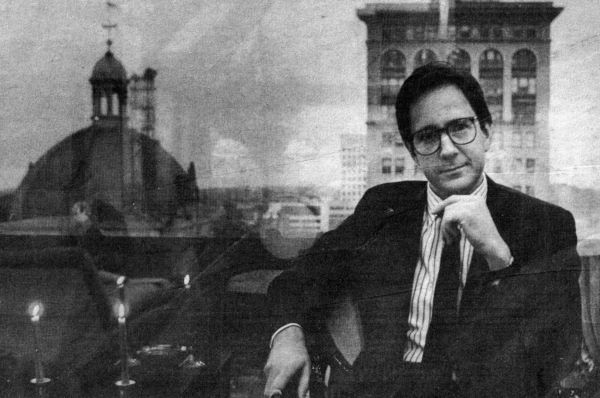
Paul Hughes, president of Hughes Media Cos., has
a good view of downtown Lexington from his offices.
Despite his success as a businessman, "my
real love has been radio programming, the marketing approach the station uses
on the air to secure listeners," Hughes said.
In 1981, he began to think about owning his own station. He met his partner,
Kevin Moore, through Moore's work as sales manager for a statewide radio
station network, the Kentucky Network.
Hughes and Moore found they had a mutual interest in radio and spent two years
researching locations to determine where a new station might work.
They formed Hughes-Moore Associates Broadcasting Co. in 1983 and obtained a
permit to operate an AM station in Midway and began building a tower on the
Midway College campus.
That decision was "Biting off more than I chew, as usual," Hughes said.
The school administration changed its position about the tower, so Hughes and
Moore had to find a new site and repeat the application process. They ended up
spending $30,000 more than they had planned.
Meanwhile, their attorney in Washington , D.C., told them about an AM radio
station in London that had gone off the air.
"We were a little leery of it," Hughes said. "We looked into Laurel County and
looked at...the community and population to determine if the station could do
well."
They bought the station's equipment and license, and they were in business.
"It's twice as hard as you might think it is," Moore said. "It's quite an
investment."
They picked an oldies format, primarily songs from the '50s, '60s and '70s.
Many of the records are from Hughes' personal collection, he said.
They chose the call letters WMAK because they had belonged to a popular
Nashville station Moore had listened to while he was growing up there. And
they picked Sam Cornett, who once worked for the original WMAK in Nashville,
as the operations manager.
Cornett previously had worked with Hughes at a Richmond station.
"He seems to be consistent," Cornett said of Hughes. "Anybody who's consistent
in this business is going to be successful. … He would not be where he is if
he didn't have some method.
Cornett said that while the station is starting small, he expects to see it
grow.
"This is the first time I have worked for a
station that signs off at sunset," Cornett said. "The reason I'm here is I do
have long-term plans with this corporation. I believe in Paul."
Moore said he and Hughes are "interested in pursuing other properties,
primarily in Kentucky." The Midway station has been on the back burner because
of WMAK, but Moore said they hope it will be on the air by spring of 1987.
Moore said that he and Hughes make a good team. "I think we complement each
other because Paul is good with the on-air part of radio and I'm goad with
sales" Moore said. "It's got to sound good, and it's got to make money."
Hughes said it is difficult to measure WMAK's listenership for advertising
purposes. Stations in smaller markets do not get ratings in the same way that
larger ones do.
"Basically, you just convince the local merchants that you're doing the right
thing," he said.
He said that community activities his station has sponsored also give it
recognition. Promotional campaigns have included a Halloween dance, opening an
abandoned bank safe to find historical "treasures" his station had planted
inside, and mailing tickets with numbers to everyone in town.
"We believe that being very locally oriented is the key in our success there.
It's not just the music that makes the radio station."
If anyone knows what makes a radio station, Hughes does, his friends say.
"He probably works too doggone hard, to tell the truth," Moore said. "But he
knows the radio business very, very well. He knows Lexington media very well."
"His strength is his intuition and knowledge in the broadcast media," Olson,
at Creative Concepts, said. "I'd put him up against anyone in that area."
Hughes' perspective has changed in one significant way -- he has gone full
circle from breaking radio rules to making them.
As a manager, he recalls his own on-air antics and acknowledges that be would
now object to such tactics.
"The one thing I've learned in radio is that you have to stay within the local
community's good-taste definition," Hughes said. "A radio station walks a fine
line when it decides to do something off color or risqué.
"It's a matter of community awareness as an
owner. You have to follow the community instinct."
 |
|
By Robert Keiser
Herald-Leader staff writer
It is 8 a.m. and Larry Holmes is short, pudgy
and white.
Most commuters listening to him on the radio as they inch towards jobs in
Lexington do not know that, though.
Only the coffee-powered morning crew at WKQQ-FM can see, through the window of
Studio B, that Holmes is really creative director Alex Bard.
Bard, whose hottest on-air impression is of Holmes, looks nothing like the
champion heavyweight. He has shoulder-length hair, a round, cherubic face and
a harder-hitting assortment of punch lines than punches.
But all that is fine, because this is radio: a never-never land where the
Eagles still play together, the 1960s live and people never look like they
should.
"You can sound like Robert Redford on the air and still look like Mickey
Rooney," said Karl Shannon, morning disc jockey at WVLK-FM.
Some listeners think it's the real Larry Holmes they hear on WKQQ, said Bard,
who also does a number of other voices for the station.
"If you have an imagination," he said, "you can create any kind of world you
want."
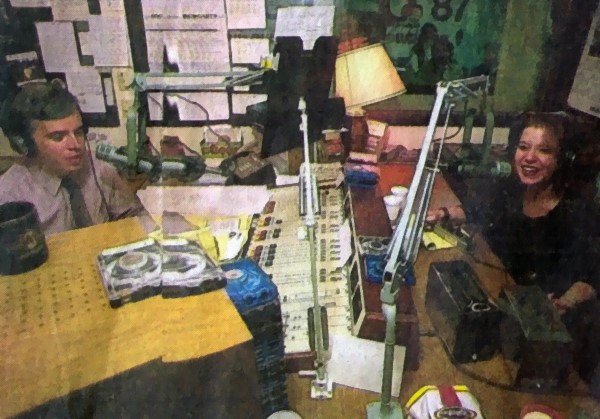 |
|
Dave "Kruser" Krusenklaus and Kelli Gates
Call letters:
WKQQ (98.1).
Target audience:
Ages 18 to 49 with emphasis on baby-boomer listeners from 25 to 40.
Typical artists
played: John Cougar Mellencamp, Bruce Springsteen and the Rolling
Stones.
Krusenklaus' favorite
artist: The Chuckwagon Gang.
Gates' favorite
artist: Zamphir, master of the pan flute.
Memorable on-air
moment: When a call-in show began to flop, Krusenklaus made a joke
about the phones not working. A General Telephone Co. repairman
promptly visited the studio to fix them.
Philosophy: "We
try to do a show in which we're just average Joes doing a radio show,"
Gates said.
|

The challenge, more than ever, is to capture
the listener's imagination in an increasingly competitive market, disc jockeys
say.
Most of that responsibility falls to the morning "drive-time" jocks, whose
shows -- all of which are live -- receive the most exposure.
"If you get a good morning team and it clicks, the rest of the day clicks,
too," said Barry Brown, general manager of WMGB-FM.
Kelli Gates, who shares the WKQQ control room each morning with Dave "Kruser"
Krusenklaus, said the "competition keeps us on our toes."
Stations in larger markets were faced with more competition after the Federal
Communications Commission deregulated radio in 1981, said Ralph Hacker,
general manager of WVLK-AM and -FM.
Until then, radio stations had been required to air some programming geared to
the town in which they were licensed to operate.
Since deregulation, stations licensed to smaller towns have been programming
to compete in larger markets nearby, Hacker said.
Central Kentucky communities with stations that compete in the Lexington
market include: Winchester (WFMI), Paris (WCOZ) and Georgetown (WMGB).
"Small towns gave up having radio stations," he said. "In every case, the
little stations were bought up by out-of-town folks and moved as close as they
could to the big city."
As a result, Lexington radio listeners have more choices than ever, Hacker
said. Bud Walters, co-owner of WFMI in Winchester, concedes that many of them
listen to at least two stations each day.
|
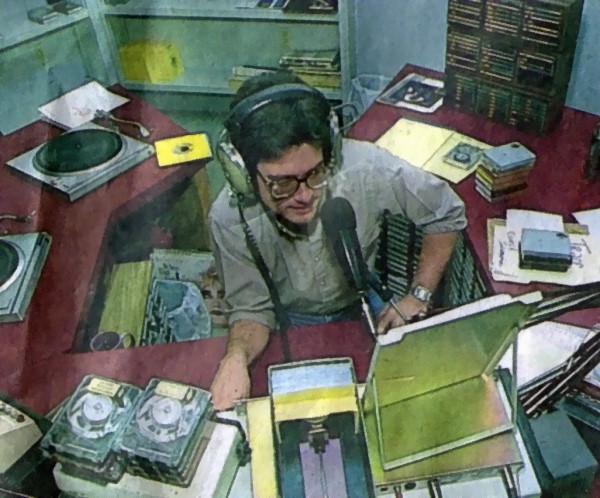 |
|
Indy Jones
Call letters:
WFMI-FM (100.1).
Target audience:
Ages 18 to 34 and women; teens.
Typical artists
played: Whitney Houston, Michael Jackson and Whitesnake:
Jones' favorite
artist: Paul McCartney.
Memorable on-air
moment: Jones, who prides himself on being quick on the uptake,
did not see the punch line coming when a man called live to suggest a
joke of the day. "Joe mamma," the man said. Jones, stunned, just
laughed. Most phone calls are taped now.
Philosophy:
"Music is the basis for our success.'"
|
Morning listeners, many of whom are facing
another day at work, search for a friend, said Frank Baker, one of the morning
"Breakfast Flakes" on WMGB-FM.
They also listen to the radio for escape, he said.
With music videos and increasingly explicit television and movies, radio
writers and personalities say their medium is the last frontier for the
imagination.
"People's imaginations are one of the neat parts of radio," said Krusenklaus,
the WKQQ disc jockey and operations manager.
Krusenklaus, 34, is a veteran disc jockey whose irreverence, quick wit and dry
brand of humor make him the David Letterman of Lexington radio.
In fact, an old issue of People magazine, its cover adorned with Letterman's
cigar-chewing face, is propped up on a table in Krusenklaus' office so that
anyone entering is greeted by them both: the wags of late night and early
morning.
Don't let Letterman's presence fool you, though. There in his office, "Kruser"
becomes Krusenklaus, the semiserious operations manager who smokes a lot of
cigarettes.
Only in the booth is he Kruser. But he clings to that identity once he walks
into the control room -- whether he's on the air or off.
"Could you grab me some coffee?" he asked Ron Mace, the station's right-hand
man.
They are in the booth, but they are not on the air.
"What do you drink, decaffeinated?" Mace asked.
"Yeah," Kruser said. "Black."
Then he smiled.
"You," he told Mace, "are like Lauren Tewes of 'The Love Boat': the perfect
cruise director."
Laughter filled the booth as the disc jockey started up Steely Dan's "Kid
Charlemagne."
"Like some people have genes for baldness or dark hair, sometimes I think I
have a performance gene in me," Krusenklaus said later.
"I'm kind of a private person….But I like to have a good time and be wild on
the air."
|
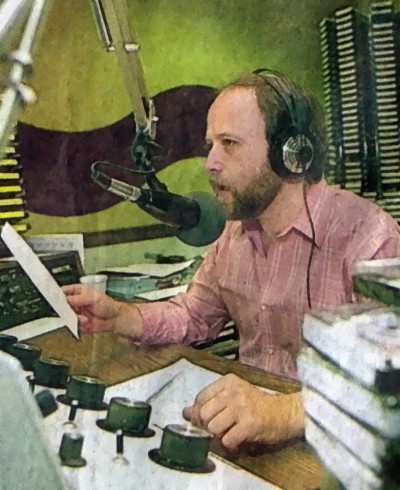 |
|
Jack Pattie
Call letters:
WVLK-AM (590).
Target audience:
Ages 25 to 54.
Typical artists
played: Bruce Springsteen, Carly Simon and Kenny Rogers.
Pattie's favorite
artist: Manhattan Transfer.
Memorable on-air
moment: Pattie doesn't care to talk about the most
memorable moment. Just say this: He wrote a letter of apology soon
afterward.
Philosophy: "If
you want to listen to music, you can always stick a tape in.
Full-service radio, like what we do, is better. Well, maybe not
better, but more solid."
|
Jack Pattie, the 35-year-old veteran disc jockey who rides WVLK-AM's morning
show, said he also had "kind of a wild, crazy image" on the air.
"But I'm not," he said.
Pattie, who looks -- and sometimes acts -- something like a life-size
leprechaun, has attracted a loyal following with his fun-poking humor and
call-in show.
He has two young daughters, one of whom gets the credit for the idea behind
his whimsical ads on LexTran buses. The ads depict Pattie hanging on the side
of the bus, his tie whipping in the wind.
Yes, this is the same man who teaches Sunday school classes and works in his
family's jewelry store in downtown Lexington.
The disc jockey's life is not glamorous, said Gary Green, 34, morning man on
WLAP-FM.
"When I get off the air, I just like to go home and play with my gerbils and
not be bothered."
On the air, it's a different story.
As long-distance owners take more risks, stations are taking more callers,
sponsoring more contests and doing more special shows. Take WKQQ's Ms. Morning
Show pageant, for instance.
For fun and prizes, the contestants parade in front of judges, including
Baird's Holmes -- in bathrobes. Oh, yes -- and they answer questions such as,
"Lava lamps: passing fad or permanent part of American culture?"
"What they're looking for is someone who's able to take a little bit of
abuse," said Phyllis O'Dell, 41, who won the 1986 pageant.
"I like the morning show," she said. "It's a lot of fun."
At least two stations -- WLAP-FM and WMGB-FM -- have tried injecting more fun
into their morning shows just this year.
WLAP-FM, which abandoned automation in favor of live broadcasts in March, has
seen its once-faltering ratings rise dramatically since the change.
|
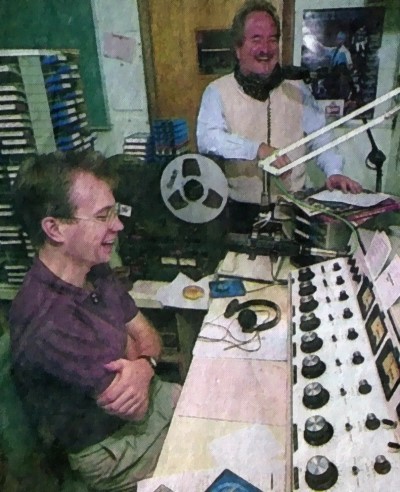 |
|
Pete Hamlett and Frank Baker
Call letters:
WMGB (103.1).
Target audience:
20 and up; women.
Typical artists
played: Steve Winwood and Whitney Houston.
Baker's favorite
artist: George Thorogood.
Hamlett' favorite
artist: Sting.
Memorable on-air
moment: Days before Lorne Green's death, Hamlett announced the
actor had died. "I guess we really scooped 'em on this story, didn't
we?"
Philosophy:
"...If listeners feel a little bit better and go to work smiling and
laughing, we've done our job," Baker said.
|
WMGB enlivened its music some but attracted
more attention by retooling its morning show March 16.
The morning disc jockeys, program director Pete Hamlett, 28, and Frank Baker,
37, are imports from Columbia, S.C. and call themselves "The Breakfast
Flakes."
Their off-the-wall humor and suggestive repartee with listeners is a mild form
of "shock radio," a popular approach in many large cities.
But even with that, Baker, who makes most of the off-color comments, would
stand out because of his Deep South accent.
The tacky joke of the day, he tells listeners, is that International Business
Machine Corp. is making a new typewriter called the presidential Selectric.
"It has no memuhry," he says in his speeded-up Jimmy Carter drawl, "and it has
no colon."
Off the air, he laughed about the joke, "I'm sick," he told Hamlett. "I'm
sick, sick."
Hamlett agreed.
"Cahmudy's tough," Baker said, grinning. "Cahmudy's tough, and we prewve it
ev'ry day."
The key to being competitive is aiming for a certain audience, general
managers say.
How each fares with listeners of different ages and men and women is reflected
in the ratings compiled by two services, Arbitron and Birch.
Those in the industry disagree on which service is more valid, but they do
agree on one thing: Birch ratings tend to favor stations with younger
listeners, while Arbitron favors those with older audiences.
Birch's summer ratings show that for all listeners, WFMI had the largest share
of listeners. Rounding out the top five were WKQQ, WVLK-FM, WLAP-FM and
WVLK-AM.
The Lexington market includes 15 stations. In Arbitron's spring book, the top
six stations overall were WLAP-FM, WVLK-FM, WFMI, WKQQ, WVLK-AM and WMGB.
The higher level of competition creates some additional pressure, disc jockeys
say.
|
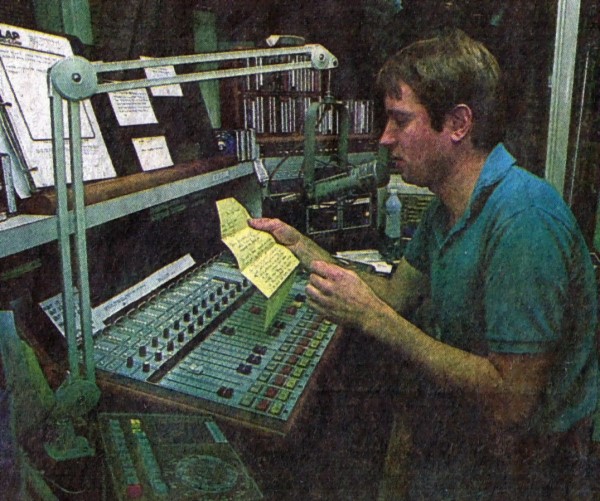 |
|
Gary Green, "The G-Man"
Call letters:
WLAP-FM (94.5).
Target audience:
Ages 18 to 49; women.
Typical artists
played: Whitney Houston, Bruce Springsteen.
Green's favorite
artist: Boxcar Willie.
Memorable on-air
moment: Green made a prank phone call, telling a woman she would
have to reschedule her wedding because of a mix-up at the site she
planned for the reception. "Oh my God," the woman said, her panic
being broadcast across Central Kentucky. "What the hell am I going to
do?"
Philosophy:
"People are primarily listening for the music, and more you yak, the
less you play.'"
|
"There's a lot more competition here than in
other places the same size," Green said.
"There's one thing about this business. When you come into one station and
mention another station's call letters, it usually rings bells."
Green, a direct but friendly man with a boyish face, bristles at the mention
of competing stations.
"We're leading the market, and you get all these little, suburban stations
acting like they're doing so well," he said, sliding headphones over his ears.
Green does have kind words for one competitor: longtime friend Indy Jones,
program director and morning disc jockey at WFMI-FM in Winchester.
Jones starts spinning dance tunes for this station's young listeners while the
streets of Winchester are still dark and the Clark County courthouse glows a
ghostly white.
"He's one tough jock," Green said, as the phone in the booth rang.
A young caller made a request.
"Sorry," Green said into the phone. "We don't play Motley Crue here."
"A lot of females listen to this station," he said after hanging up, "and they
wouldn't like Motley Crue much."
"That kid who called is probably 13 or 14 years old and wears black T-shirts."
Not exactly WLAP-FM's target audience.
"The targeted audience is something more and more advertisers are looking
for," said Brown, the general manager of WMGB.
Radio has made a comeback since stations began targeting their audience more,
Brown said.
"I think what has happened with radio (is) it's a lifestyle medium now," Brown
said. "You can have access to it almost anywhere you go. And young Americans
are tremendously active now."
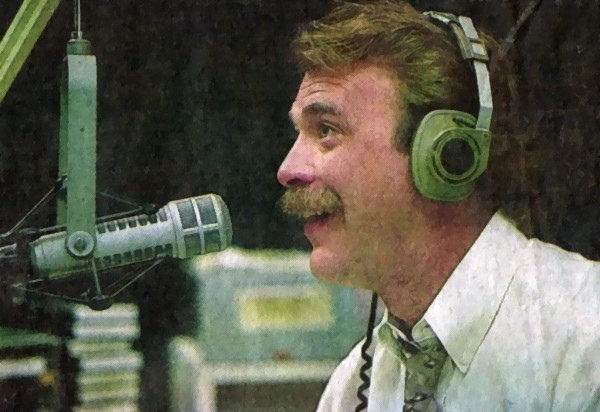 |
|
Eric Stevens
Call letters:
WLAP-AM (630).
Target audience:
Ages 25 to 49 with emphasis on 35 and older.
Typical artists
played: Lionel Richie, Huey Lewis & The News and Marvin Gaye.
Stevens' favorite
artist: Steve Winwood.
Memorable on-air
moment: Once, at another station, while Stevens was telling
listeners about a flood in which people died, a co-worker laid on his
stomach on a table and made paddling motions with his arms. Stevens
had to struggle to keep from laughing during the somber newscasts --
and was not entirely successful.
Philosophy: "The
greatest compliment anybody can pay me is for them to say, 'Hey, he's
my friend on the radio.'"
|
That includes disc jockeys, said Eric
Stevens, WLAP-AM's morning man.
"You gotta be active," said Stevens, who WLAP newsman Craig Cheatham
good-naturedly calls "GQ Johnny Fever."
Fever was the ragged morning disc jockey on the now-syndicated television
series "WKRP in Cincinnati."
Stevens is an amiable, outgoing man who wears his hair swept back, his shirts
crisp and his ties straight.
He stays active doing wedding receptions, parties and picnics to supplement
his income.
"It's a high-risk, low-profit field," he said.
Especially in the mornings. On a recent day, the clock said it soon would be
10 a.m., and the booth around Stevens was filled with smoke.
He took a drag from still another cigarette and chased the nicotine with
coffee.
"Boy, I sit here and chain-smoke and drink coffee like crazy," he said,
smiling. "This show's hazardous to my health, I tell you."
Stevens sighed and looked up at the clock on the wall. "One more contest to
go," he said.
Moments later, the clock said 10.
The phone was still, another morning was over, and Stevens plugged in one last
song:
"Happy trails to you,
"Until we meet again.
"Happy Trails to you,
"Keep smilin' until then…"

 |
